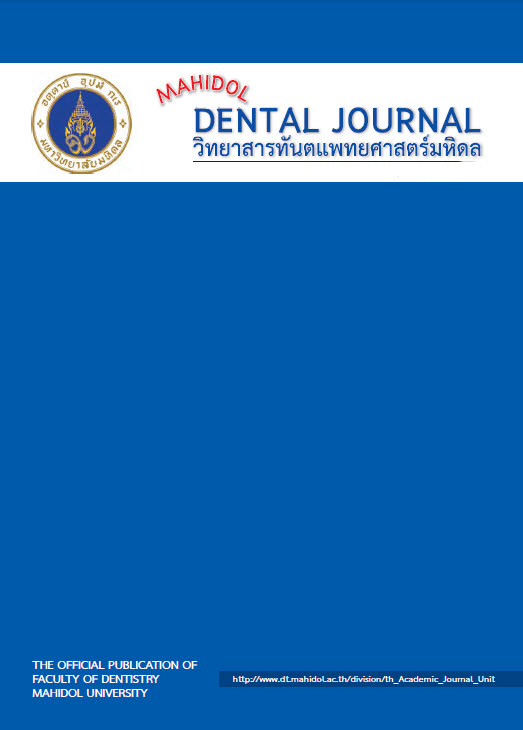Strength of disposable floss holders: A new test model of applying vertical force to dental floss
Main Article Content
Abstract
Objective: To compare strengths of seven disposable floss holders, which were five F-shaped and two Y-shaped, by applying vertical force to floss attached on each holder.
Materials and Methods: This study employed an experimental design. Each floss holder was held on the dental stone platform while testing was conducted, using the Instron universal mechanical testing machine. This machine exerted the force vertically at the mid length of the dental floss until the floss was torn or pulled out. The failure force that caused tear or pull-out of the dental floss was recorded. The data was then analyzed statistically with one-way ANOVA and Tukey’s multiple comparison (α=0.05). Weibull analysis was also performed. Moreover, the percentage of the failure characteristics of the floss holder was recorded.
Result: All types of floss holders passed the strength test at 11 N as recommended by Dörfer et al. (2001). The failure characteristics were dental floss pull-out of the holder (F1, F2, F4, Y1, Y2) rather than the tear of the floss (F3, F5). There were statistically significant differences (p<0.001) between the maximum force in the F3 group and almost all other groups except the F5 group. The F3 group showed the maximum strength and Weibull modulus at 46.64 and 14.98, respectively. The F2 group, despite passing the strength test, showed the minimum strength consistency (Weibull modulus of 4.79).
Conclusions: To summarize, all dental floss holders pass the standard; F3 group showed the maximum strength, while the F2 group had the least strength consistency. Overall, the connection between dental floss and floss holder plays the key role determining the strength of this appliance.
Article Details
References
Wright GZ, Banting DW, & Feasby WH. The Dorchester dental flossing study: final report. Clin Prev Dent. 1979; 1(3): 23-6.
Ong G. The effectiveness of 3 types of dental floss for interdental plaque removal. J Clin Periodontol. 1990; 17(7): 463-6.
Galgut PN. The need for interdental cleaning. Dent Health (London). 1991; 30(5): 8-11.
Bergenholtz A, & Brithon J. Plaque removal by dental floss or toothpicks. J Clin Periodontol. 1980; 7(6): 516-24.
Graves RC, Disney JA, & Stamm JW. Comparative Effectiveness of Flossing and Brushing in Reducing Interproximal Bleeding. J Periodontol. 1989; 60(5): 243-7.
Lobene RR, Soparkar PM, & Newman MB. Use of dental floss. Effect on plaque and gingivitis. Clin Prev Dent. 1982; 4(1): 5-8.
Spolsky VW, Perry DA, Meng Z, & Kissel P. Evaluating the efficacy of a new flossing aid. J Clin Periodontol. 1993; 20(7): 490-7.
Pucher J, Jayaprakash P, Aftyka T, Sigman L, & Van Swol R. Clinical evaluation of a new flossing device. Quintessence Int. 1995; 26(4): 273-8.
Carter-Hanson C, Gadbury-Amyot C, & Killoy W. Comparison of the plaque removal efficacy of a new flossing aid (Quik Floss®) to finger flossing. J Clin Periodontol. 1996; 23(9): 873-8.
Zanatta FB, Moreira CH, & Rosing CK. Association between dental floss use and gingival conditions in orthodontic patients. Am J Orthod Dentofacial Orthop. 2011; 140(6): 812-21.
Wolff A, & Staehle H. Improving the mechanical properties of multiuse dental floss holders. Int J Dent Hyg. 2014; 12(4): 245-50.
Dörfer CE, Wündrich D, Jörg Staehle H, & Pioch T. Gliding Capacity of Different Dental Flosses. J Periodontol. 2001; 72(5): 672-8.
Hanes PJ, O'Dell NL, Bacp MR, Keagle JG, & Davis HC. The effect of tensile strength on the clinical effectiveness and patient acceptance of dental floss. J Clin Periodontol. 1992; 19(1): 30-4.
Della Bona A, Anusavice KJ, & DeHoff PH. Weibull analysis and flexural strength of hot-pressed core and veneered ceramic structures. Dent Mater. 2003; 19(7): 662-9.
Ritter JE. Predicting lifetimes of materials and material structures. Dent Mater. 1995; 11(2): 142-6.
Roos M, & Stawarczyk B. Evaluation of bond strength of resin cements using different general-purpose statistical software packages for two-parameter Weibull statistics. Dent Mater. 2012; 28(7): e76-88.


